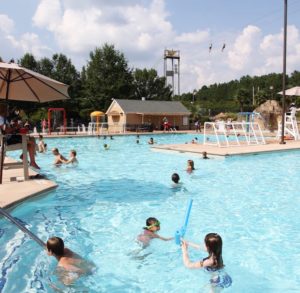Three Truths
About Families Who Foster and Adopt - Observations from the Side of the Pool
350 people were there—almost exclusively foster families and adoptive families. We had an enormous pool, a kids’ summer time favorite—greased watermelon polo, a hilarious DJ, and a triple zip line racing above the fun. We couldn’t ever come up with the right name for the gathering so we just call it “Big Fun Family Day,” because… well, that’s what it is, or at least that’s what it looks like. As I made my way around the pool, here’s what I found and, consequently, learned about the foster-adoptive community.
 While I talked to one couple who had recently adopted, their young son quietly headed back to the pool and went one step too deep. There were two very long seconds where we each saw his little eyes peering up toward the sky as he attempted to get his mouth above water for a couple of panicked breaths. His mom raced toward him, lifted him out of the pool, and held him. The weight of the moment caught up with me. With a large family myself, I’ve also had this moment before. Afterwards, fear and guilt surface. How could I have looked the other way, been distracted, or not acted sooner? 2 seconds can be forever!
While I talked to one couple who had recently adopted, their young son quietly headed back to the pool and went one step too deep. There were two very long seconds where we each saw his little eyes peering up toward the sky as he attempted to get his mouth above water for a couple of panicked breaths. His mom raced toward him, lifted him out of the pool, and held him. The weight of the moment caught up with me. With a large family myself, I’ve also had this moment before. Afterwards, fear and guilt surface. How could I have looked the other way, been distracted, or not acted sooner? 2 seconds can be forever!
After all, the foster-adoptive community is not one that’s apt to look away from a child in need. Our work, our calling, our lives, are aligned with the simple idea that a child is everyone’s responsibility. The phrase “it takes a village to a raise a child” is not a cliché to us. It’s an invitation to identify enough “villagers” so that every child will have a family. However, the boy’s little panicked eyes are a reminder of how difficult this dream truly is. We are not perfect parents. Whether it’s our best or worst moment, both will contain a gaping hole that reminds us, we are not enough for the children in our care. This acknowledgement is not about our guilt, fears, or failures as much as pointing out the absolute necessity that our community be built on grace. Our calling requires that we extend grace to children, but too few of us extend it to ourselves. Our community is about grace, or at least is should be, because it must be. Grace is our best option, and our only option.
On the other side of the pool deck, a family shared with me that they had spent the better part of the previous day walking through conversations about suicide with a teen foster child. There’s a rawness to the foster-adoptive community. In this case, most of the conversation was held in brief spurts while a younger foster daughter played in the water, popping in and out of the conversation. As the adults, we spoke in code, allowing the younger child to enjoy the bliss of a perfect summer day.
Amongst our community, these extremes rub shoulders all day long: bliss and pain, life and death, joy and suicide. The parents become gradually fluent in both, almost like a doctor in a hospital moving from one room to the next, signing release papers with one, then sharing a terminal diagnosis with another. The effect on our community is an unusual authenticity. We’re authentic for the sake of survival. We share openly within our community, not knowing how or through whom God will provide the information or encouragement that will lead us, or our children, toward life.
In the same hour, another family shared that the child they had been fostering for months had moved along and into a home where everyone planned they’d stay forever. A month later, things had not gone as planned. The disruption required my friends to consider moving beyond only fostering to adopting. For one day, they shelved their picture of the future and prayed, “Thy will be done.” That same day, a different family prayed the same prayer and received this child into their home. In the same 24-hour window, my friends wrestled and said “yes,” only to then mourn the loss of their newly-adopted plan. Of course, with how things shift in foster care, this family newest to the story may not be the forever home either, so my friends will keep their foster home open, waiting… just in case.
Waiting is a familiar word in the foster-adoptive community. I remember noting somewhere in middle school that the Spanish word for wait, esperar, could either mean “to wait” or “to hope.” In 7th grade, it didn’t make sense and it doesn’t make much more sense now. But actually, a famous verse, Isaiah 40:31, deals with this same distinction.
"But those who hope in the Lord, will renew their strength." (NIV) | "But they who wait for the Lord shall renew their strength." (ESV)
In the foster-adoptive community, we do both. Some days we wait and some days we hope. The subtle difference affects us deeply. We know waiting comes with the territory and we prefer to replace our neutral waiting with a more positive hope. But when we can’t muster up true hope? We wait anyway.
I never actually got in the pool at Big Fun Family Day, but I did get to glance below the surface of many families’ lives in the foster-adoptive community. I was reminded of how much we need grace, authentic relationships and good, old-fashioned hope in a good God who will work it all out.
For Christians doing this work, what’s critical is not that we act or communicate perfectly as parents or wait and hope in complete serenity. We know the object of our efforts is ultimately God – an act of worship even. Try as we will, we cannot control the outcomes for our children, which seems particularly and painfully obvious in adoption and foster care. The two translations of Isaiah 40:31 may differ in part, but the end- this outcome - does not. The Lord will renew our strength. He is the hope for our community.
Andy Cook currently serves as President and CEO of Promise686. He and his wife, Martha, are the parents of ten energetic children ranging in age from 3 - 18.



Pat hensley
August 2, 2017 at 7:41 amAwesome peek inside the complexity of being a foster family. The sacrifice of a “normal” life shines through and foster families are truly living a sanctified life in service for our Lord.